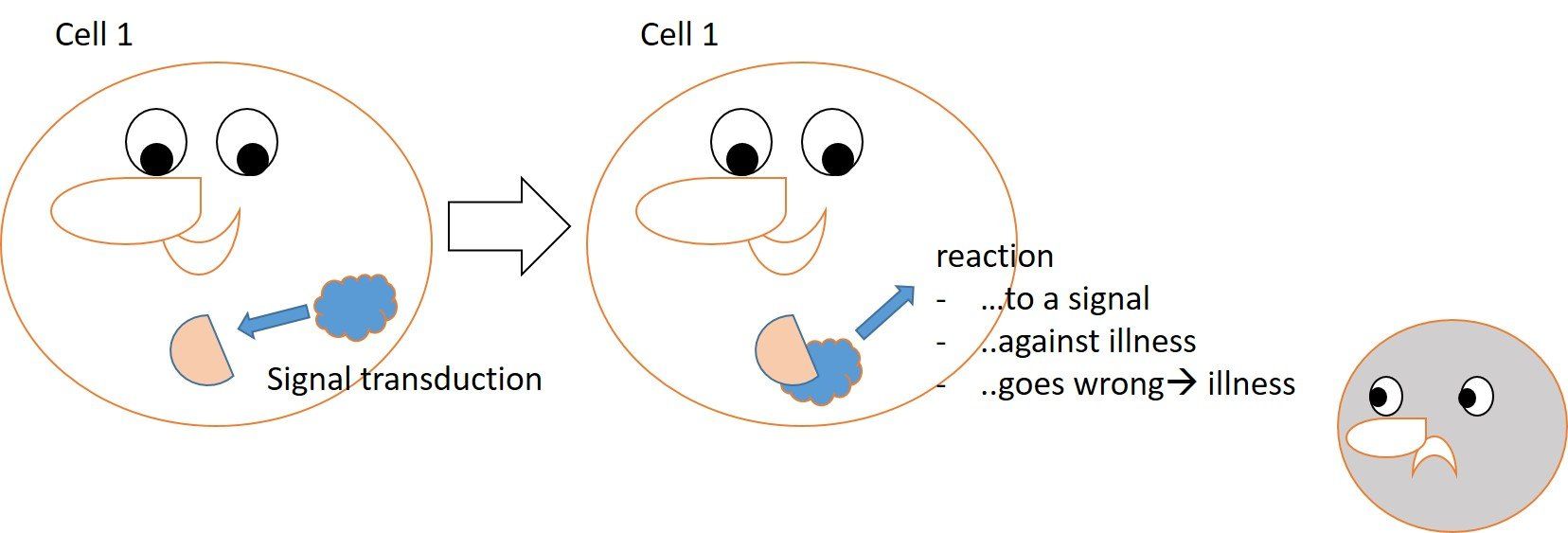Disease models and signal transduction
In multicellular organisms, like humans or the zebrafish, cells are the smallest organizational units. Within the cell, the nucleus lies with our genetic material included. Depending on the cell type the genetic material is activated differently which leads to a different kind of protein composition within each cell. Imagine a construction site: the nucleus is comparable with the project leader, proteins are comparable with the workers. Cells can (and have to) communicate with each other to maintain the function of the whole organism and also to respond to surrounding stimuli. Disorders and problems with communication can result in diseases, like cancer.
Each cell can send signals that affect the surrounding cells, or travel on short or long distances, until the message reaches other cellular targets. Proteins or other molecules function as signals. In the target cell the molecules bind to receptors which influence the cell behavior.
Often, interactions between receptors and proteins are necessary to enhance the signal. This is how a, so called, signaling cascade emerges. At a construction site workers have to team up sometimes to solve problems and communicate with the outside world. A signal is often forwarded to the nucleus to change the expression of genes. Proteins bind to regulatory elements on the DNA which induce new formations of proteins via coding DNA regions.
Coding regions in the “construction plan” tell us, which workers should be active. On the other hand, regulatory regions tell us, when they should be active. This depends on the state of the “construction site” and “deliveries” from the outside. Newly built proteins trigger reactions to signals; this can be a change of the cell shape or in cell metabolism.
Biosensors
The cell processes take place on the molecular level and are not directly visible. To understand their role within the organism it is necessary to observe them in the living organism. How can this be achieved?
To observe if a signal leads to the activation of a given gene, there is the possibility to artificially copy regulatory regions usually working for that gene and add a construction plan to make a fluorescent dye. The regulatory copies are inserted into the genetic material. When a certain signal reaches the cell, activation of both, the natural gene and the artificial fluorescent starts, which can be seen via microscopy. By choosing a green fluorescent protein as dye, all cells reacting to certain signals, will emit green light. When the fluorescent dye is not only coupled with regulatory response, but also with the protein encoded by a specific gene , one can see the location of that protein within the cell. “A new worker gets a coloured helmet by the project leader”. There are also other fluorescent dyes, which can change their colour after binding to molecules and can thereby show cell activity of e. g. a neuron.
The applications of the zebrafish “biosensors” are numerous: one can study the cell signalling throughout the normal development of an embryonic tissue, during the physiological function of an adult organ, under particular pathological or stress conditions, in the tumorigenic process, or in the drug response. The remarkable transparency of the zebrafish allows performing such studies in intact animals and in real time, under working conditions hardly obtainable using mammalian models.
This leads to a better understanding of processes leading to diseases and helps to find new therapies.





